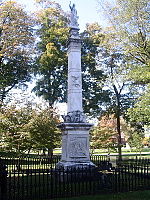Battle of Minisink
| Battle of Minisink | |||||||
|---|---|---|---|---|---|---|---|
| Part of the American Revolutionary War | |||||||
 Monument in Goshen, New York over mass grave of Minisink battle dead |
|||||||
|
|||||||
| Belligerents | |||||||
|
|
|
||||||
| Commanders and leaders | |||||||
|
John Hathorn{w} Benjamin Tusten† |
Joseph Brant | ||||||
| Strength | |||||||
| 120 militia/elements of 4th Orange County regiment | 60 Iroquois 27 Tories |
||||||
| Casualties and losses | |||||||
| 48 killed 1 captured |
3 killed 10 wounded |
||||||
The Battle of Minisink was a battle of the American Revolutionary War fought at Minisink Ford, New York, on July 22, 1779. It was the only major skirmish of the Revolutionary War fought in the northern Delaware Valley. The battle was a decisive British victory, as the colonial militia was hastily assembled, ill-equipped, and inexperienced.
Although British forces were largely concentrated on Manhattan Island, Joseph Brant, a Mohawk war chief and a Captain in the British Army, was sent along with his Brant's Volunteers on a quest for provisions, to gather intelligence on the Delaware in the vicinity of Minisink, and to disrupt the upcoming American Sullivan Campaign.
In July 1779, he received word that Kazimierz Pulaski's forces had moved into Pennsylvania, leaving much of the Delaware Valley undefended. Brant led his force of Loyalists and Iroquois raiders through the valley, with the goal of seizing supplies and demoralizing the colonists. The settlers were forced to flee to more populated areas, and Brant pursued them. On July 20, he reached Peenpack, which he attacked immediately. Brant ordered that "they should not kill any women or children" or Loyalists and to take prisoner any who surrendered. His raid was a crushing success and, leaving Fort Decker and the settlement in ruins, Brant and his force continued north along the Delaware River.
Later that day, riders from Peenpack reached the village of Goshen, telling of Brant's raid and the destruction of the town. A militia formed immediately, under the reluctant command of Lieutenant Colonel Benjamin Tusten. Tusten was strongly opposed to pursuing the raiders, as he knew they would be no match for the British and Iroquois soldiers, and he suggested waiting for reinforcements from the Continental Army. However, the majority of the public and the militia underestimated the fighting ability of the Iroquois and demanded immediate retribution. Outvoted, Tusten agreed to set out the following morning. They met up with elements of the Fourth Orange County Regiment ordered from Warwick by George Washington and led by Colonel John Hathorn. Colonel Hathorn assumed command and marched for the Delaware with a force of about 120 minutemen.
...
Wikipedia
